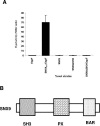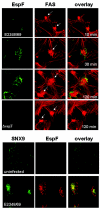EspF of enteropathogenic Escherichia coli binds sorting nexin 9
- PMID: 16585770
- PMCID: PMC1447016
- DOI: 10.1128/JB.188.8.3110-3115.2006
EspF of enteropathogenic Escherichia coli binds sorting nexin 9
Abstract
EspF of enteropathogenic Escherichia coli targets mitochondria and subverts a number of cellular functions. EspF consists of six putative Src homology 3 (SH3) domain binding motifs. In this study we identified sorting nexin 9 (SNX9) as a host cell EspF binding partner protein, which binds EspF via its amino-terminal SH3 region. Coimmunoprecipitation and confocal microscopy showed specific EspF-SNX9 interaction and non-mitochondrial protein colocalization in infected epithelial cells.
Figures





Similar articles
-
EPEC effector EspF promotes Crumbs3 endocytosis and disrupts epithelial cell polarity.Cell Microbiol. 2017 Nov;19(11):10.1111/cmi.12757. doi: 10.1111/cmi.12757. Epub 2017 Jul 27. Cell Microbiol. 2017. PMID: 28618099 Free PMC article.
-
The type III effector EspF coordinates membrane trafficking by the spatiotemporal activation of two eukaryotic signaling pathways.J Cell Biol. 2007 Sep 24;178(7):1265-78. doi: 10.1083/jcb.200705021. J Cell Biol. 2007. PMID: 17893247 Free PMC article.
-
E. coli secreted protein F promotes EPEC invasion of intestinal epithelial cells via an SNX9-dependent mechanism.Cell Microbiol. 2010 Jul;12(7):919-29. doi: 10.1111/j.1462-5822.2010.01440.x. Epub 2010 Jan 20. Cell Microbiol. 2010. PMID: 20088948 Free PMC article.
-
Comparative analysis of EspF variants in inhibition of Escherichia coli phagocytosis by macrophages and inhibition of E. coli translocation through human- and bovine-derived M cells.Infect Immun. 2011 Nov;79(11):4716-29. doi: 10.1128/IAI.00023-11. Epub 2011 Aug 29. Infect Immun. 2011. PMID: 21875965 Free PMC article.
-
Sorting out the cellular functions of sorting nexins.Nat Rev Mol Cell Biol. 2002 Dec;3(12):919-31. doi: 10.1038/nrm974. Nat Rev Mol Cell Biol. 2002. PMID: 12461558 Review.
Cited by
-
Exploitation of eukaryotic subcellular targeting mechanisms by bacterial effectors.Nat Rev Microbiol. 2013 May;11(5):316-26. doi: 10.1038/nrmicro3009. Nat Rev Microbiol. 2013. PMID: 23588250 Free PMC article. Review.
-
Mitotic Arrest-Deficient 2 Like 2 (MAD2L2) Interacts with Escherichia coli Effector Protein EspF.Life (Basel). 2021 Sep 15;11(9):971. doi: 10.3390/life11090971. Life (Basel). 2021. PMID: 34575120 Free PMC article.
-
EPEC effector EspF promotes Crumbs3 endocytosis and disrupts epithelial cell polarity.Cell Microbiol. 2017 Nov;19(11):10.1111/cmi.12757. doi: 10.1111/cmi.12757. Epub 2017 Jul 27. Cell Microbiol. 2017. PMID: 28618099 Free PMC article.
-
EspJ of enteropathogenic and enterohaemorrhagic Escherichia coli inhibits opsono-phagocytosis.Cell Microbiol. 2008 May;10(5):1104-15. doi: 10.1111/j.1462-5822.2007.01112.x. Epub 2008 Jan 14. Cell Microbiol. 2008. PMID: 18201246 Free PMC article.
-
Actin cytoskeleton manipulation by effector proteins secreted by diarrheagenic Escherichia coli pathotypes.Biomed Res Int. 2013;2013:374395. doi: 10.1155/2013/374395. Epub 2012 Dec 30. Biomed Res Int. 2013. PMID: 23509714 Free PMC article. Review.
References
-
- Crane, J. K., B. P. McNamara, and M. S. Donnenberg. 2001. Role of EspF in host cell death induced by enteropathogenic Escherichia coli. Cell. Microbiol. 3:197-211. - PubMed
-
- Creasey, E. A., R. M. Delahay, S. J. Daniell, and G. Frankel. 2003. Yeast two-hybrid system survey of interactions between LEE-encoded proteins of enteropathogenic Escherichia coli. Microbiology 149:2093-2106. - PubMed
-
- Frankel, G., A. D. Phillips, L. R. Trabulsi, S. Knutton, G. Dougan, and S. E. Matthews. 2001. Intimin and the host cell—is it bound to end in Tir(s)? Trends Microbiol. 9:214-218. - PubMed
Publication types
MeSH terms
Substances
Grants and funding
LinkOut - more resources
Full Text Sources
Other Literature Sources
Molecular Biology Databases
Miscellaneous

